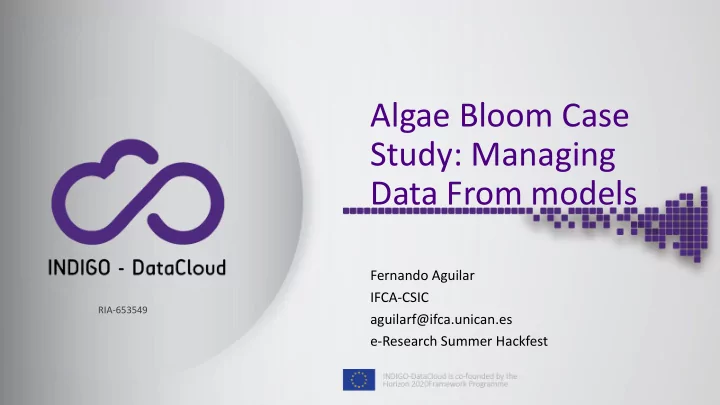

Algae Bloom Case Study: Managing Data From models Fernando Aguilar IFCA-CSIC RIA-653549 aguilarf@ifca.unican.es e-Research Summer Hackfest
Research Community • LifeWatch is an ESFRI oriented to Biodiversity and Ecosystems research. • Under LifeWatch umbrella many different projects will be supported, both on basic and applied research. • This Case Study on the Modeling of a Water Reservoir & Prediction of Algae Bloom is a collaboration of IFCA and Ecohydros SL, an Spanish SME working for CHD (Duero river water authorities). • It is a long standing collaboration (>10 years), and many steps have been given: • Deployment and integration of complex remote instrumentation • Data taking and visualization • Modeling of the whole system, including hydrological and biological model (DELFT-3D) • Validation of the model and predictive system ALGAE BLOOM ARE DUE TO EUTROPHICATION PROBLEMS, AND POINT TO PROBLEMS IN WATER QUALITY MANAGEMENT • Community interest: authorities (local, regional, national, European level), researchers on fresh-water systems (as a basic framework for modeling and simulation of ecological processes) • Deployment of new monitoring stations in lakes and water reservoirs
Introduction • Framework: Collaboration within European LIFE+ project (ROEM+). SME Ecohydros. • Reservoir hydrodinamic and Water Quality modelling. Cuerda del Pozo: water supply, water activities. • Previous work • Platform takes data from water: physical, chemical, biological, etc. Allows to know water status (data taken since 2010 aprox.) • Data visualization tool. Aims to alert authorities when the water quality is under the limits. INDIGO-DataCloud RIA-653549
Scientific problem • One more step: knowing before an event happens the status of the water using modelling tools (Delft3D used in cloud). • Goal: alert authorities not only in real time but before. • The main problem is eutrophication: INDIGO-DataCloud RIA-653549
Scientific problem • Within 5 years of continuous monitoring in CdP Reservoir, this is the cyanobacterias concentration close to the dam: 2013 2014 Dolichospermum crassum Colonias Microcystis Colonias Woronichinia 2010 - 2011 novacekii naegeliana Dolichospermum planctonicum Dolichospermum INDIGO-DataCloud RIA-653549 Aphanizomenon flos-aquae crassum
Computing and data model • Delft3D-FLOW: Different resolutions (Bathymetry, 5-40m horizontally, 0.5-3m vertically, 35 layers). Z-model. • Number of input parameters: • Tributaries/Initial conditions: flow, temperature, salinity. • Meteo: Rain, air temp, humidity, solar radiation, wind. • Interrelationship between parameters. 6 Integrating distributed data infrastructures with INDIGO-DataCloud
Computing and data model • Goal: Reproduce thermocline and water level. • Not easy, but very good results. 7 Integrating distributed data infrastructures with INDIGO-DataCloud
Computing and data model • Water Quality: More complex model due to the number of processes involved. • Goal: reproduce algae bloom. • Input: hydrodynamic output, nutrient concentrations (initial/tributaries), initial algae concentrations, sediments, other coefficients/ratios (mortality, growth, ratio chl/C, etc.). 8 Integrating distributed data infrastructures with INDIGO-DataCloud
Computing and data model • We tried to model it increasingly, adding parameters one by one: Continuity>Oxygen>Nutrients… • The model is not validated yet. Problems found. • Oxigen is not well distributed in the water column. • Nutrients (Phosphatus, Nitrates) decreasing (and dissapear). • Algae trend to die. • Tests in forced scenarios (sweep): • +50% nutrients • +90% nutrients • Analyze Results: Ophidia? 9 Integrating distributed data infrastructures with INDIGO-DataCloud
Implementation strategy • OneData: Key component! • We need a storage distribution solution: link inputs-computing-outputs. Sharing capabilities. • Input – Output files up to 50Gb. Problem? • Schedule: • Docker: Delft3D (Done) • Create OneData Space. • Upload input files. • Mount OneData client with Delft3D • Test With 1 model. • Add Parameter sweep. • Test with N models. • Check Outputs. 10 Integrating distributed data infrastructures with INDIGO-DataCloud
Implementation strategy • Ophidia: Very interesting. • Model outputs: N parameters in time and space. • Parameter interrelationship: Nutrients Vs. Algae, Temperature Vs. Oxygen, etc. In time + In Space/time. • Schedule: • Test 1 param in time • Test 2 params in time • Test 5 params in time • Test 1 param in space/time (2D and 3D) • Test 2, Test 5… 11 Integrating distributed data infrastructures with INDIGO-DataCloud
Implementation strategy • Kepler: interesting. • Model outputs must be analyze after completing. • We have an R script to analyze thermoclines: Model Vs. Real Data. • Kepler could fit on this. • Schedule: • Workflow to run script (R) with an input file. • Workflow to compare input file with real data (from MySQL dataset). • Very ambitious: Link Delft3D output (in docker) with Kepler. 12 Integrating distributed data infrastructures with INDIGO-DataCloud
Summary OneData Output Kepler Ophidia 13 Integrating distributed data infrastructures with INDIGO-DataCloud
Bonus: TRUFA OneData 14 Integrating distributed data infrastructures with INDIGO-DataCloud
Recommend
More recommend